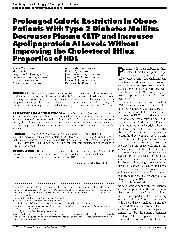摘要
OBJECTIVE-Using a mouse model for human-like lipoprotein metabolism, we observed previously that reduction of the hepatic triglyceride (TG) content resulted in a decrease in plasma cholesteryl ester transfer protein (CETP) and an increase in HDL levels. The aim of the current study was to investigate the effects of prolonged caloric restriction in obese patients with type 2 diabetes mellitus, resulting in a major reduction in hepatic TG content, on plasma CETP and HDL levels.
RESEARCH DESIGN AND METHODS-We studied 27 obese (BMI: 37.2 +/- 0.9 kg/m(2)) insulin-dependent patients with type 2 diabetes mellitus (14 men and 13 women, aged 55 +/- 2 years) who received a 16-week very low calorie diet (VLCD). At baseline and after a 16-week VLCD, plasma lipids, lipoproteins, and CETP were measured. Furthermore, functionality of HDL with respect to inducing cholesterol efflux from human monocyte cells (THP-1) was determined.
RESULTS-A 16-week VLCD markedly decreased plasma CETP concentration (-18%; P < 0.01) and increased plasma apolipoprotein (apo)AI levels (+16%; P < 0.05), without significantly affecting plasma HDL-cholesterol and HDL-phospholipids. Although a VLCD results in HDL that is less lipidated, the functionality of HDL with respect to inducing cholesterol efflux in vitro was unchanged.
CONCLUSIONS-The marked decrease in hepatic TG content induced by a 16-week VLCD is accompanied by a decrease in plasma CETP concentration and an increase in apoAI levels, without improving the cholesterol efflux properties of HDL in vitro.
- 出版日期2011-12
